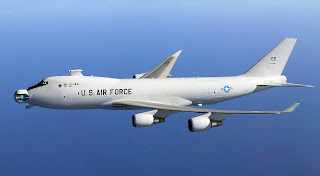The Boeing YAL-1 Airborne Laser Testbed (formerly Airborne Laser) weapons system was a megawatt-class chemical oxygen iodine laser (COIL) mounted inside a modified Boeing 747-400F. It was primarily designed as a missile defense system to destroy tactical ballistic missiles (TBMs) while in boost phase. The aircraft was designated YAL-1A in 2004 by the U.S. Department of Defense.
The YAL-1 with a low-power laser was test-fired in flight at an airborne target in 2007. A high-energy laser was used to intercept a test target in January 2010, and the following month, successfully destroyed two test missiles. Funding for the program was cut in 2010 and the program was canceled in December 2011. It made its final flight on February 14, 2011 to Davis–Monthan Air Force Base in Tucson, Arizona to be kept in storage at the "Boneyard" by the 309th Aerospace Maintenance and Regeneration Group. It was ultimately scrapped in September 2014 after all usable parts were removed.
The Airborne Laser Laboratory was a less-powerful prototype installed in a Boeing NKC-135A. It shot down several missiles in tests conducted in the 1980s.
The Airborne Laser program was initiated by the US Air Force in 1996 with the awarding of a product definition risk reduction contract to Boeing's ABL team. In 2001, the program was transferred to the MDA and converted to an acquisition program.
The development of the system was being accomplished by a team of contractors. Boeing Defense, Space & Security provides the aircraft, the management team and the systems integration processes. Northrop Grumman was supplying the COIL, and Lockheed Martin was supplying the nose turret and the fire control system. More details
The Airborne Laser Laboratory was a less-powerful prototype installed in a Boeing NKC-135A. It shot down several missiles in tests conducted in the 1980s.
The Airborne Laser program was initiated by the US Air Force in 1996 with the awarding of a product definition risk reduction contract to Boeing's ABL team. In 2001, the program was transferred to the MDA and converted to an acquisition program.
The development of the system was being accomplished by a team of contractors. Boeing Defense, Space & Security provides the aircraft, the management team and the systems integration processes. Northrop Grumman was supplying the COIL, and Lockheed Martin was supplying the nose turret and the fire control system. More details

